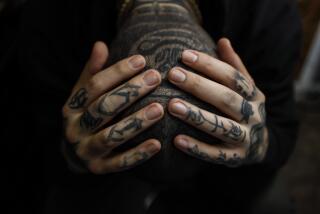Pulling Strings : Daisy Lee Brings the Ancient Art of Tying Knots to Her New Homeland
- Share via
Knots are symbolic enough in Western cultures. “Tying the knot” is a metaphor for marriage. There are true lovers’ knots, the Gordian knot and knotty problems. London taxi drivers, when incensed with other drivers, may shout: “Get knotted!”--an expression marginally less offensive than “Get stuffed!” In Clive Barker’s recently published collection of horror stories, “The Inhuman Condition” (Poseidon Press $12.95), the story that gives the book its title is about knots that sinisterly tie and untie themselves.
But if knots have symbolic meaning to Westerners, how much more they have to the Chinese. Lydia Chen, in the introduction to her book, “Chinese Knotting” (Echo Publishing Co., Taiwan, 1982), wrote: “To study the design of Chinese knots is to enter the world of Chinese folk symbols of good fortune. In the pages ahead you will encounter designs fashioned after symbols of longevity, happiness, Buddhist treasures, prosperity and the commonality of all being, to name just a few.”
Chen’s book--not easily obtainable in the United States--shows, in diagrams, how to tie some of the elaborate knots that for thousands of years have fastened sashes, held up palace lanterns and wind chimes, and ornamented many everyday objects from fan tassels to lacquered boxes.
Daisy Lee, who was Chen’s pupil for six years in Taipei, Taiwan, came to Los Angeles in 1985 with her husband, James Lee. They now teach Chinese knotting at various centers in the Los Angeles area. About 30 different knots are taught. “Anyone can learn,” Daisy Lee says--and, to prove it, she showed me how to tie a quite professional-looking knot in red rayon cord. I was a butterfingers at school ballgames, a muff at arms drill in the school army corps, and the only boy in woodworking class who, when making a table lamp, managed to drill the hole for the cord so that it emerged from the side of the lamp instead of the end. But under Daisy Lee’s tuition, I managed to tie a complex knot, winding the cord round my left forefinger (“Not too tight,” Daisy Lee advised), then moving up a gold bead, as on an abacus.
The knots that Daisy Lee herself ties are of labyrinthine complexity. They are also very beautiful. “We can custom-make things,” she says. “If someone says they want a turtle--or a fish, a peacock or a Christian symbol--I can make it.”
It is always irritating, if you are an artist, to be asked, “How long did it take you to do this?”--as though the value of a work of art were quantifiable in man-hours. Nevertheless, I asked Daisy Lee how long it took her to make a Christian cross suspended between two knots as many-twisted as a garden maze. “Half an hour.” It seemed incredible. But like the Dutch forger, Hans van Meegeren, when it was suggested at his trial (on a charge of collaborating with the Nazis) that he couldn’t fake a Vermeer to save his life, Daisy Lee just sat down and gave a demonstration. Within a minute she had already strung together some mesmerizingly complicated knots.
James and Daisy Lee married in Taiwan 14 years ago. It was an old-fashioned “arranged marriage.” Their parents knew each other and thought James and Daisy were suitable for each other--and they were. The couple have two children, aged 13 and 12, but the children have not yet been taught Chinese knotting. “They must learn English first,” Daisy Lee says.
The Lees do not sell their work; the price of any knotted goods made in America could be easily undercut by Taiwanese products. All the Lees’ energies go into teaching. “We will give a free demonstration to show you what a Chinese knot is,” James Lee says. “Western people think of the Chinese people as kung fu and dragons; they don’t understand that we have many good cultures and crafts.”
The Lees’ pupils include 10-year-olds and grandfathers. A typical course costs $60, which includes the cost of materials and the fees for eight classes, one a week. But some courses cost less, and certain cities organize free classes for senior citizens. For a list of class locations, write to Daisy Lee, Chinese Knot Promotion Center, 219 S. Del Mar Ave., Apartment D, San Gabriel, Calif. 91776.
More to Read
Sign up for our Book Club newsletter
Get the latest news, events and more from the Los Angeles Times Book Club, and help us get L.A. reading and talking.
You may occasionally receive promotional content from the Los Angeles Times.










